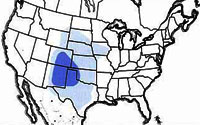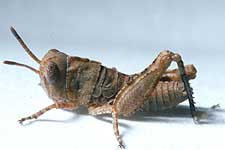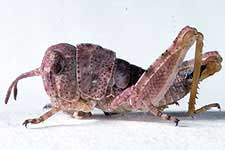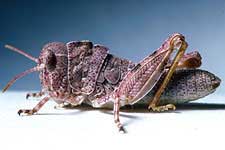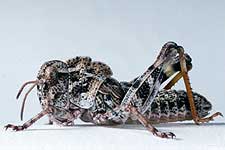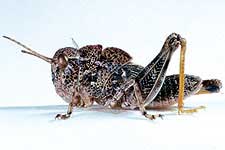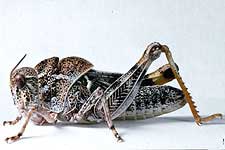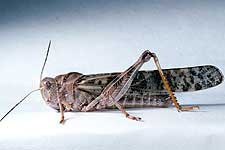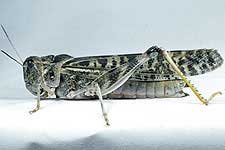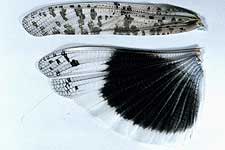|
Wyoming Agricultural Experiment Station Bulletin 912
Distribution
and Habitat Click here for the printable version
The High Plains grasshopper inhabits the shortgrass prairie, a floral province dominated by shortgrasses, principally blue grama and buffalograss. In addition, this province supports a moderate amount of three or four species of midgrasses in any one locality. Common among these midgrasses are western wheatgrass, needleandthread, sand dropseed, red threeawn, and galleta hilaria. Also present in the shortgrass prairie are several sedges, forbs, and small shrubs along with much interspersed bare ground. The biogeographic map of the High Plains grasshopper shows an inner area (colored dark blue) where scouts found both nymphs and adults during the 1934-40 outbreak of the species and an outer area (colored pale blue) where they collected only adults. During the outbreak, swarms of the High Plains grasshopper dispersed widely from habitats of their origin. The species has been recorded infrequently in assemblages of rangeland grasshoppers during nonoutbreak years, yet it continues to survive and reproduce in especially favorable habitats. Such a habitat occurs in Otero County, Colorado, 5 miles southwest of Hawley. The area is characterized by sandy loam soil (Olney) with a 0 to 3 percent slope. Readily absorbing rainfall, the soil fosters an abundance of three midgrasses (sand dropseed, galleta hilaria, and red threeawn) in addition to the short grasses, (blue grama and ring muhly). The High Plains grasshopper can be a pest of rangeland grasses. During outbreaks enormous numbers completely devour the grasses in their habitat. Hatching from concentrated egg beds, the young grasshoppers spread out in all directions from these loci and eventually consume the grasses of the invaded areas. When the nymphs become older they march in bands seeking food. In their progression they completely consume the grasses of the rangeland and any fields of wheat, barley, corn, or millet they encounter. The adults have a propensity to migrate in huge, flying swarms and cause forage and crop destruction wherever they land. During the 1934-40 outbreak, ranchers whose pastures were infested found it necessary to move their cattle to distant pastures only to have these destroyed by alighting swarms. These dire outcomes forced many ranchers to sell their entire herds. Described in 1872 by Cyrus Thomas, the High Plains grasshopper was considered a rare species until migrating swarms were observed in Colorado in 1890 and the first known outbreak was recorded a year later (Table 1). The most recent outbreak from 1934 to 1940 was calamitous. Entomologists now recognize that this grasshopper may also occur as a damaging member of destructive rangeland assemblages. The High Plains grasshopper is one of the largest species among those destructive to rangeland forage. Collected in the Hawley site on 16 July 1997, live weight of males averaged 647 mg and of females 1,371 mg (dry weight: males 245 mg, females 450 mg). Food HabitsThe High Plains grasshopper is a general grass feeder. Field entomologists have often reported this grasshopper's damage to short grasses (blue grama and buffalograss), but it feeds also on midgrasses. In two-choice preference tests, the High Plains grasshopper fed as well on midgrasses (sand dropseed, needleandthread, and galleta hilaria) as on blue grama. Although it fed on western wheatgrass, this host was not consumed as much as the other midgrasses. The feeding of five late instar nymphs and 13 adults was observed in their natural habitat (Hawley, Colorado) during the summer of 1997. Four nymphs and nine adults fed on sand dropseed, one adult fed on blue grama, and one on needleandthread. One nymph and an adult were observed feeding on ground litter. Although the grasshoppers were observed to taste leaves of nearby plants before feeding, no evidence was obtained of their moving to find particular species of grass. Spring 1997 was very dry in Otero County, Colorado. When the majority of observations of feeding were made, sand dropseed had been grazed heavily by cattle and grasshoppers. Plants were short with stems grazed down to 1 to 3 inches, and most leaves were dry. The grasshoppers fed chiefly on the short stems that were still green. Evidently these conditions of sand dropseed made the plants convenient for High Plains grasshoppers to attack from their usual positions on the ground. The common method of attack by a High Plains grasshopper was to walk up to a grass plant, taste it, and while remaining horizontal on the ground surface begin to feed at the tip of a low-lying leaf or on the stub of a grazed stem. When leaves were higher, the grasshopper raised up diagonally on the plant at approximately a 45° angle and began to feed on a leaf at or near the tip. The hindlegs remained on the soil surface, the midlegs on the plant, and the tarsi of the front legs handled the leaf conveying it to the mouthparts. Only once was a grasshopper observed feeding off the ground in the middle of a grass plant facing head down and feeding on a leaf or stem. The High Plains grasshopper appeared to be a very thrifty feeder as no clipping and dropping of leaves were observed. Laboratory observations revealed that whenever these grasshoppers severed a leaf, they held on to it and consumed all of the green but dropped the yellow, dry tissue. Dispersal and MigrationThe High Plains grasshopper is a very mobile insect. During outbreak years huge numbers of hatching nymphs, up to 2,000 per square yard, soon crawl away from the egg beds that range in size from one-half to 200 acres and average about 15 acres. Dispersal usually begins near the end of the first week after emergence and increases rapidly as nymphs age. The rate of travel of first instars was clocked at 3 feet per minute, the third instar at 6 to 12 feet, and late instars at more than 10 feet per minute. In 1937 one band of nymphs was found to travel 2 1/2 miles in one day. In 1993 and 1997 in Colorado's Bent and Otero counties, nymphs at low densities of less than 1 per square yard appeared to remain close to their hatching sites. Soon after transforming to the adult stage, the grasshoppers of dense populations begin to disperse. On their first flights, they cover from 25 to several hundred yards at a time and at heights of less than 50 feet. Later, the adults rise in swarms taking high, long flights that disperse the grasshoppers widely over great distances. Swarms appear to fly during both day and night; the lights of cities attract huge numbers and induce them to land. In 1937, 2,940 adults were marked with nontoxic paints to determine direction and distance of migratory flights. Sixteen grasshoppers were recovered 1 to 13 days later and at distances of 17 to 175 miles mainly in a northwest direction from the point of release. The results indicated that rate of movement ranged from 10 to 37 miles per day and that the grasshoppers flew with the prevailing winds. After the grasshoppers land in distant pastures, they concentrate into populations numbering about 20 per square yard. Fourteen days later the females begin to deposit eggs. At this time the adults no longer migrate, but they make regular low flights of one-half to 3 miles between egg beds and feeding grounds. Observations of small populations, less than one per square yard, in Otero County, Colorado in 1997 revealed that the adults form mating aggregations of approximately one adult per square yard on one-quarter to one-half acre of land. Three aggregations approximately 1 mile apart were discovered in an infested area of 6 square miles. As the whole area was not inspected, it is probable that several other aggregations were undetected. Flushed flight is usually silent without crepitation, but a soft rustling of the wings is sometimes audible. Distances traveled ranged from 1 foot in early morning to more than 90 feet at midday at heights of 4 inches to 3 feet. The short flights are straight but the long flights are either straight or zig-zag and circuitous. Toward the end of a long flight, the grasshoppers may make a right angle turn before landing. Identification
A conspicuous insect in the shortgrass prairie, the High Plains grasshopper is distinguished by its large size, attractive black hindwings, and quick, elusive flight (Fig. 7 and 8). The hindwings have a transparent outer margin bordering the large black disk that widens greatly at the apex and is marked by several large fuscous spots (Fig. 9). The tegmina or forewings are pale tan with many large brown spots. The median pronotal crest is notably high and deeply incised once. The inner side of the hind femur is yellow with two large dark markings near the middle. The hind tibia is distinctively golden. Wingspans of males range from 2 1/2 to 3 3/8 inches, and females 3 1/4 to 4 inches. The nymphs are identifiable by their color, shape, and external structures (Fig. 1-6). 1 . Head with face nearly vertical; antennae filiform, majority of segments pale tan, terminal segments dark; lateral foveolae small and triangular; compound eyes tan or brown with light spots; usually narrow light band on side of head behind the compound eye. 2. Pronotum with median carina strongly elevated and incised once. 3. Hind femur with medial area tan and often with three transverse diagonal dark bars, inner medial area tan with two or three black transverse bars; hind tibia of instars I and II black with pale yellow annulus located proximally, instar III black and tan or entirely golden, instar IV, V, and VI golden. 4. General body color tan with brown round spots; venter generally immaculate cream to yellow. The high pronotal crest and tan, heavily spotted body are diagnostic features of the younger nymphs. The golden hind tibia and high pronotal crest are diagnostic features of the older nymphs. HatchingThe High Plains grasshopper is an intermediate-hatching species; the first instars appear two to three weeks after Aulocara elliotti nymphs. In 1939 the first hatch occurred May 2 in Colorado. Because of an unusually warm spell in the spring of 1939 in eastern New Mexico and the Texas Panhandle, hatching began two to three weeks earlier than normal on April 21. In 1997 in Colorado's Bent and Otero counties, hatching was calculated to have begun on May 14. The hatching period usually lasts from 11 to 18 days but may be extended to 30 days by spells of cold weather. In egg beds with southern exposures, the hatch is sooner and faster than in those with northern exposures. Nymphal DevelopmentNymphs develop in late spring when temperatures are warm and grasses young and green. In 1939, based on the dates of first appearance of nymphs and first adults, the developmental period lasted 44 to 45 days in Colorado, New Mexico, and the Texas Panhandle. In New Mexico and Texas the majority of nymphs had five instars, while in Colorado they had six. Adults and ReproductionThe first adults of the High Plains grasshopper appear in June. In 1939 they were discovered June 5 in New Mexico and Texas and June 15 in Colorado. In 1997 the first adults appeared in Bent and Otero Counties, Colorado on June 25. Maturation of the females is lengthy, as they require six to seven weeks before laying their first clutch of eggs. In 1939 this occurred July 17 in New Mexico and August 1 in Colorado. Male courtship of females appears to be brief. Only two observations of this behavior were made in nature. On 1 August 1997 at 8:35 a.m. DST, a male was discovered walking on bare ground. He approached within a few inches of a basking female and began to signal with his hindlegs. The female raised her hindlegs to reject him, but he persisted in the approach, still signaling. Within an inch of her, he jumped suddenly and mounted. The female knocked him off and walked 3 feet away. Caged males have been seen to signal the females by femur-tipping and vibratory stridulation followed by sudden leaps onto the females that sometimes end in a successful mating. Observations made in 1939 revealed that most egg deposition occurred between 9 and 12 a.m. when air temperatures ranged from 80° to 90° F. At the beginning of this period they made shallow holes without depositing eggs. Later on, they selected bare ground around the edges of grass plants and dug holes into the soil depositing large clutches of eggs nearly 2 inches deep. Several males usually attended the ovipositing female. In a laboratory cage a female took 1 hour and 5 minutes from the start of drilling to withdrawal of the ovipositor. Afterward she used her hind tarsi for 1 minute to cover the aperture with soil particles and debris. In nature, a male mounts the female immediately after oviposition and mates successfully. Egg beds occurred in various soil types, but during the 1934-40 outbreak the greatest number were found in sandy loam soil. The majority of pods were deposited in egg beds, although a few were interspersed in the extensive areas between them. In the spring survey of 1939, 187 pods were examined and found to contain an average of 65 eggs with a range of 32 to 84. The egg pod is large and slightly curved ranging from 1 to 2 inches long (Fig. 10). The eggs, 4.4 to 5.6 mm long, are pale yellow when laid but eventually turn tan. Population EcologyPopulations of the High Plains grasshopper irrupt during periods of drought and above-normal temperatures. Rainfall and temperature have their greatest influence during the hatching period when the nymphs are delicate. Numerous observations made during the 1934-40 outbreak revealed that cold, wet weather decimated populations of young nymphs and warm, clear weather fostered their welfare. When the nymphs were older, rains had little effect on survival. Biotic factors reducing populations during the outbreak were predatory birds, rodents, and insects. These took their toll, yet many adults survived through August and September and a few into October. A thorough summary of the life history, ecology, and control of the High Plains grasshopper was published in 1958 by Claude Wakeland as USDA Technical Bulletin 1167. Daily ActivityIn spite of its notorious reputation as a strong migratory flier, the High Plains grasshopper spends most hours on bare ground in its habitat. In the shortgrass prairie southwest of Hawley, Colorado, late instars and adults did not seek shelter at night but rested horizontally on bare ground within an inch of clumps of grass. After sunset they often crawled short distances, but in the morning before sunrise they were immobile. In the summer of 1997, ground temperatures at the Hawley site were approximately 77° F at sunset and 65° F shortly before sunrise. One-half to one hour after sunrise, the grasshoppers adjusted their bodies to bask. They rested horizontally on bare ground, turned a side perpendicular to rays of the sun, and lowered the associated hindleg to expose more of the abdomen. In July and August, basking lasted two to three hours, approximately from 6 a.m. to 9 a.m. DST. During this time individuals may turn around 180° and continue basking, or they may walk distances of 4 to 6 inches and then resume basking, apparently in a better location. During the basking period almost all High Plains grasshoppers rest quietly, absorbing the heating rays of the sun. Toward the end of this period, a few individuals may walk short distances to find a host plant and feed. A few males may also start to court nearby females. Of 18 observations of feeding, seven occurred between 8 and 9 a.m., six between 9 and 10 a.m., four between 10 and 11 a.m., and one at 2:51 p.m. DST. Temperatures of the unshaded soil surface during the period of morning feeding ranged from 85° to 112° F; shaded air at 1 inch high ranged from 67° to 90° F. The temperature at the time of the one afternoon observation of feeding registered 130° F at the soil surface and 105° F air. Courting was observed twice between 8:35 and 8:49 a.m. 1 August 1997, but no pairs in cap were seen anytime. In the Hawley site on clear days the ground temperatures rose rapidly in July and August, reaching 120° F by 10 a.m. DST. Heat induced the grasshoppers to stilt and to face directly into the sun or to face directly away from the sun. As temperatures rose further, the grasshoppers crawled onto the top of short grasses raising the body about an inch above the soil surface and away from the surrounding hot bare ground. They assumed a diagonal orientation on top the short grass facing the sun directly and shading the body. Observed in low-density populations of less than one individual per square yard and away from egg beds, the High Plains grasshopper appears mainly quiescent-little jumping, walking, or flying unless flushed. After the basking period on 21 August 1997 from 9:20 to 11:08 a.m. DST, four appetitive flights of 15 to more than 50 feet were observed when ground temperatures ranged from 100° to 123° F and air temperatures from 77° to 85° F. Appetitive walking (pottering) was also observed on five different days. Eight observations revealed movements of 1 1/2 to 15 feet over bare ground; the grasshoppers usually broke the walk into two or three segments separated by brief pauses. Wakeland, Claude. 1958. The High Plains grasshopper, a compilation of facts about its occurrence and control. USDA Tech. Bull. 1167. Willis, H. R. 1939. Painting for determination of grasshopper flights. J: Econ. Entomol. 32: 401-403. |
